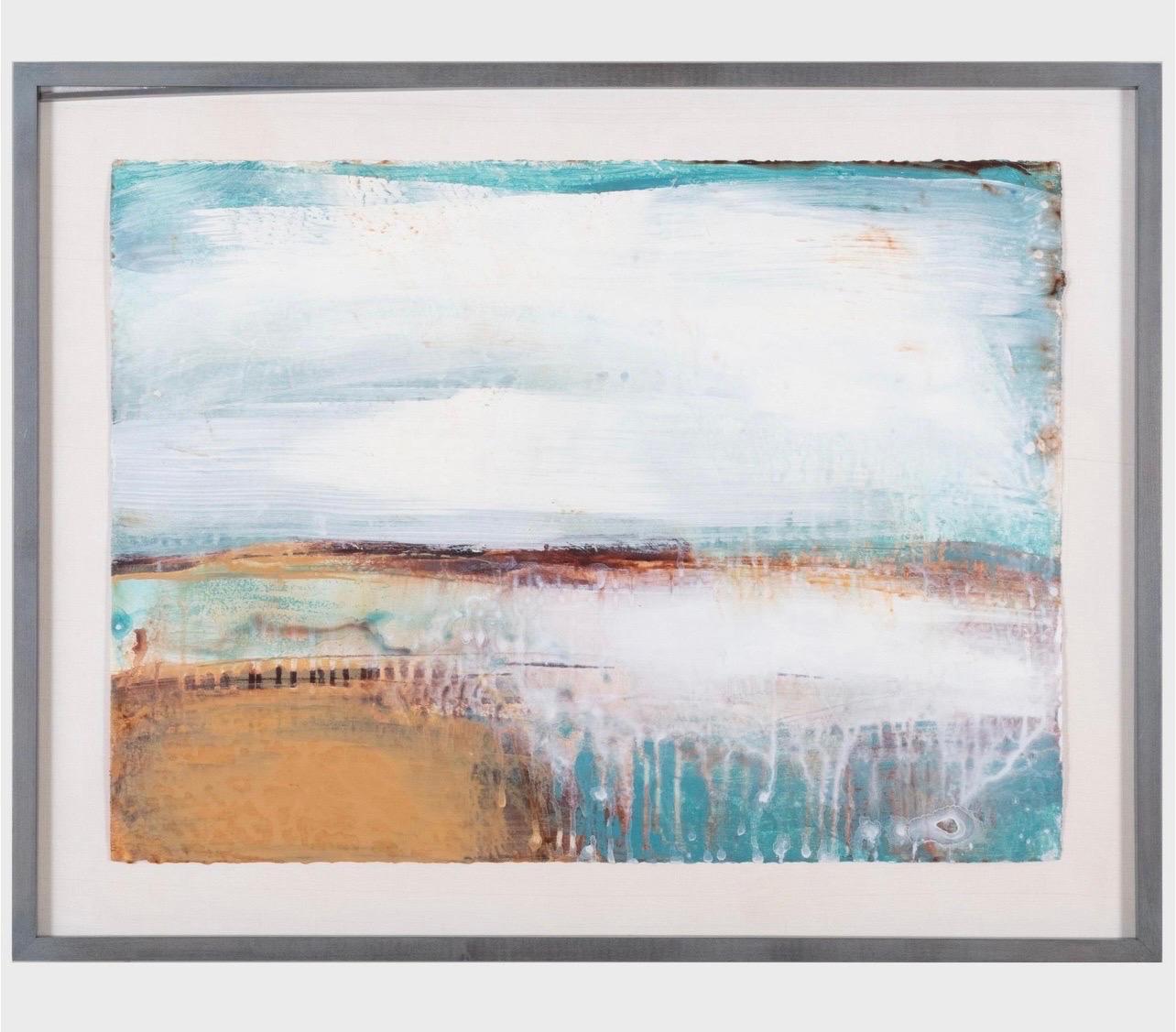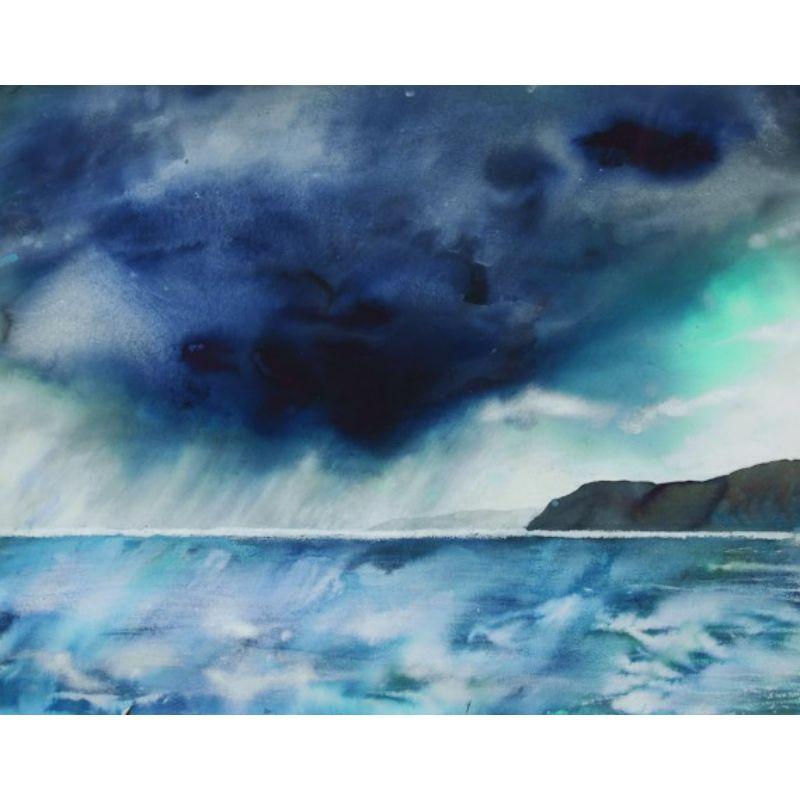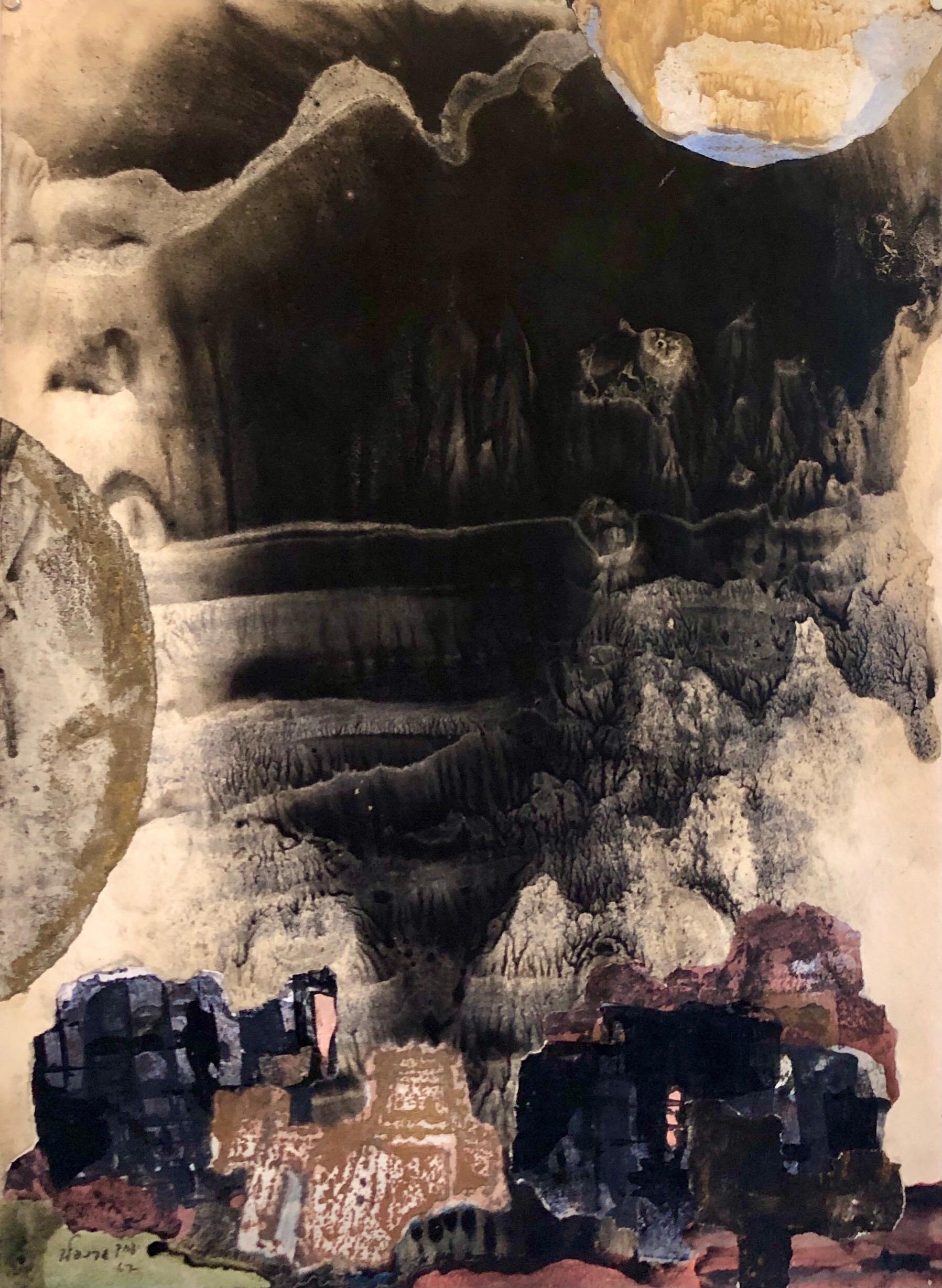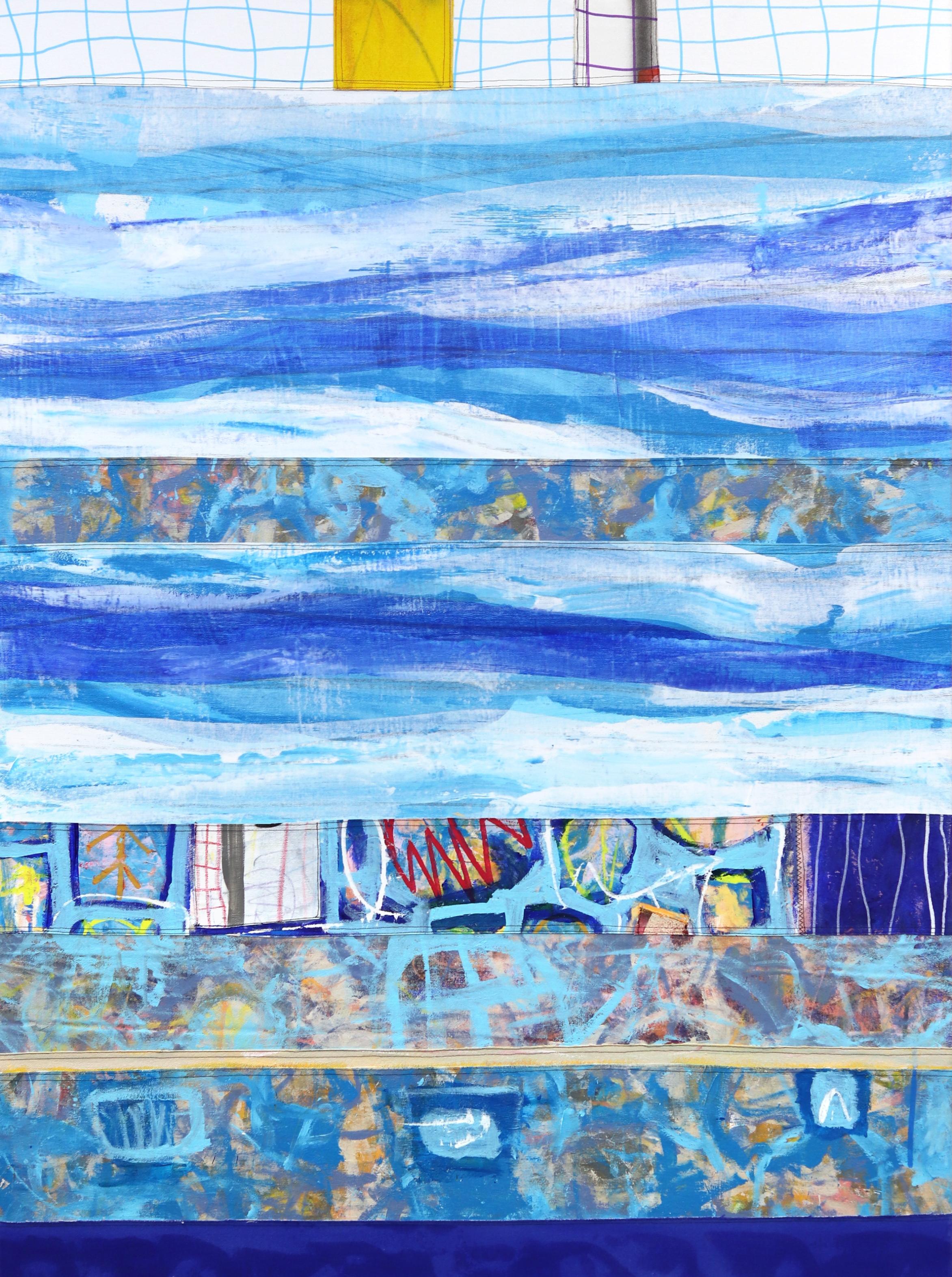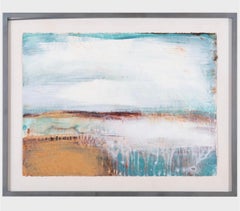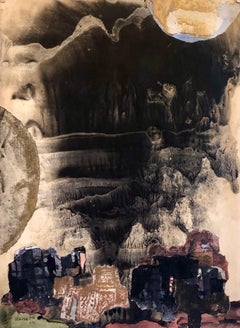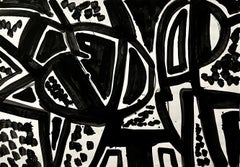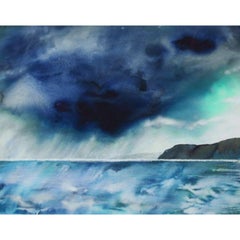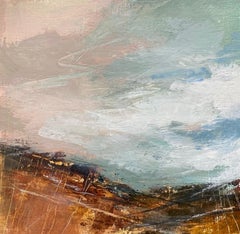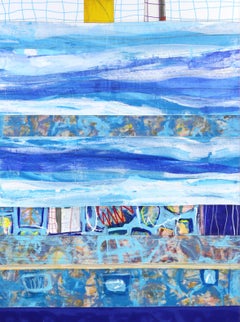Items Similar to Abstract Expressionist Virtues Landscape Venetian Plaster Painting Shawn Dulaney
Want more images or videos?
Request additional images or videos from the seller
1 of 16
Shawn DulaneyAbstract Expressionist Virtues Landscape Venetian Plaster Painting Shawn Dulaneyc. 2010-2011
c. 2010-2011
About the Item
Shawn Dulaney
The Virtues IV
Handmade paint on venetian plaster on paper,
signed and titled verso
22 x 30 in. (sheet), 28 1/4 x 36 1/4 in. (frame).
Shawn Dulaney’s paintings are layered constructions of color, spacious abstractions that read like cloud banks, flows of water, magnetic fields charged with monumental energy. Dulaney spent her childhood on a vast Colorado plateau looking west to the Rocky Mountains and has travelled widely, immersing herself in landscape. Her work captures the experience and feeling of place. Doug McClemont of ArtNews writes that Dulaney’s paintings “concern the earth, and the unyielding hand of nature”.
Her work has been described by William Zimmer of The New York Times as belonging to “a very strong tradition, that of 19 th -century Northern European Romanticism in which nature was seen as corresponding to human emotional states.” He says of her work, “Ms. Dulaney makes it clear that her inner life is very much a part of each painting, and this alone distinguishes it from most abstraction…Shawn Dulaney is deliberately out for grandeur, but she is also out for intimacy. Her paintings take advantage of their innate ambiguity and declare themselves to be very current in the thinking that lies behind them.” "The kind of painting to which Ms. Dulaney's work is most closely related, at least superficially, is the Mark Rothko branch of Abstract Expressionism, in which a sense of deep space is sought."
Dulaney makes handmade paints consisting of acrylic medium and powdered pigments allowing her to get a wide range of saturations and transparencies as they spread out on Venetian plaster and linen over panel. “Her surfaces”, as described by Dominick Lombardi-also of The New York Times, are “exquisitely painted and a pleasure to see.”
Dulaney continues to travel between New York, the American Southwest, and the United Kingdom, as well as having recently been awarded the Pink House Artist Residency on the Beara Peninsula in Ireland. Her paintings capture the ephemeral and evoke the Celtic notion of a “thin place”, a place of energy where the veil between this world and the eternal is thin. A working artist for over 4 decades, Dulaney is represented by Sears Peyton Gallery, Weber Fine Art, Carrie Haddad Gallery and Beth Urdang Gallery. Exhibited widely, her paintings can be found in extensive public and private collections including those of the Hunterdon Museum of Art in NJ, the Venetia Resort in China, J Crew in NYC, as well as in the private collections of author Annie Proulx, actor Steve Buscemi, talk-show host Conan O’Brien and musician Stuart Copeland. Her work has appeared in episodes of TV’s Enlightened, Portlandia and Sex & the City, and the films It’s Complicated (2009), Interview (2007) and John Wick 3 (2019). Her work has been reviewed in ArtNews and The New York Times, and has been featured in Parabola and New American Paintings. A contemporary, Post war American woman artist. She currently lives and works in Brooklyn, NY.
Select Group Exhibitions
2022 - Sears-Peyton Gallery, Playground, New York, NY
2022 - Weber Fine Arts, Summer Exhibition Renate Aller, Shawn Dulaney, Carin Riley, and Margaret Evangeline.
2022 - Beth Urdang Gallery, BLUE: Painting Photographs Prints & Sculpture, Wellesley, MA
2022 - Sears-Peyton Gallery, Spring Fling, New York, NY
2022 - Carrie Haddad Gallery, Bold Little Beauty, Hudson, NY Julia Whitney Barnes, Linda Newman Boughton, Sue Bryan, Shawn Dulaney, Susan Hope Fogel and Betsy Weis
2021 - Beth Urdang Gallery, BLUE: Paintings Photographs Prints, June Wellesley, MA
2021 - Carrie Haddad Gallery, Place as Memory, Hudson, NY Richard Britell, Sue Bryan, Shawn Dulaney, Susan Hope Fogel, Ricardo Mulero, Linda Newman Boughton, Leigh Palmer, and photographs by Eric Lindbloom
2021 - Weber Fine Art, Spring Exhibition Featuring Shawn Dulaney, Carin Riley, Robert Polidori and Chen Jiagang,
2020 - Weber Fine Art, Winter Exhibition Featuring Renate Aller, Shawn Dulaney, Carin Riley, and Margaret Evangeline, Greenwich, CT
2019 - Weber Fine Art, Winter Exhibition Featuring Alex Katz, Carin Riley, Shawn Dulaney, and Louise Fishman,
2009 - Weber Fine Art, with Hans Hoffman & Wolf Kahn, Scarsdale, NY
2006 - Karan Ruhlen Gallery, Inner Space, 4 artists referencing nature in landscapes exploring emotional terrain,
2005 - Weber Fine Art, Inspiration and Influence, Shawn Dulaney/Hans Hoffman, Paintings, Scarsdale, NY
1997 - Gallery at Hastings-On-Hudson, "Fresh/Fresco:The New Age of Fresco"
1996 - The Arvada Center for the Arts, "Eggs, Milk & Wax: Old techniques in New Paintings", Arvada, CO
1996 - Smack Mellon Studio, "Pattern and Relief", Brooklyn, NY
1995 - Robischon Gallery, "Revisiting the Past", Denver CO
1994 - Boston College Museum of Art, "Fresco: A Contemporary Perspective", Chestnut Hill, MA
Publications
- Architectural Digest, November 2022, Cover feature, 11/22 (Upcoming)
– Reviews, New York By Doug McClemont, ARTnews, April 2012 pg. 111
– Works of Subtle Transcendence from a Master Artist, Parabola Magazine, Spring 2012
– H, C & G Hamptons Magazine, 2007
– Karan Ruhlen Gallery By Craig Smith, Pasatiempo/The Santa Fe New Mexican, May 2006
– Versatile with a Cross-over Style By Dominick Lombardi, The New York Times WE, April 2004
– From Different Palettes, Texture, Color and Light By Dominick Lombardi, The New York Times WE, April 2003
– Paint Layered Over Poetry By William Zimmer, The New York Times WE, May 2001 cover of Arts & Entertainment
– New American Paintings #20, Open Studios Press, February 1999
- Creator:Shawn Dulaney (1956, American)
- Creation Year:c. 2010-2011
- Dimensions:Height: 28.25 in (71.76 cm)Width: 36.25 in (92.08 cm)
- Medium:
- Movement & Style:
- Period:
- Condition:
- Gallery Location:Surfside, FL
- Reference Number:1stDibs: LU38211234782
About the Seller
4.9
Platinum Seller
Premium sellers with a 4.7+ rating and 24-hour response times
Established in 1995
1stDibs seller since 2014
1,744 sales on 1stDibs
Typical response time: 2 hours
- ShippingRetrieving quote...Shipping from: Surfside, FL
- Return Policy
Authenticity Guarantee
In the unlikely event there’s an issue with an item’s authenticity, contact us within 1 year for a full refund. DetailsMoney-Back Guarantee
If your item is not as described, is damaged in transit, or does not arrive, contact us within 7 days for a full refund. Details24-Hour Cancellation
You have a 24-hour grace period in which to reconsider your purchase, with no questions asked.Vetted Professional Sellers
Our world-class sellers must adhere to strict standards for service and quality, maintaining the integrity of our listings.Price-Match Guarantee
If you find that a seller listed the same item for a lower price elsewhere, we’ll match it.Trusted Global Delivery
Our best-in-class carrier network provides specialized shipping options worldwide, including custom delivery.More From This Seller
View AllAbstract Expressionist Virtues Landscape Venetian Plaster Painting Shawn Dulaney
By Shawn Dulaney
Located in Surfside, FL
Shawn Dulaney
The Virtues III
Handmade paint on venetian plaster on paper,
signed and titled verso
22 x 30 in. (sheet), 28 1/4 x 36 1/4 in. (frame).
Shawn Dulaney’s paintings are layered constructions of color, spacious abstractions that read like cloud banks, flows of water, magnetic fields charged with monumental energy. Dulaney spent her childhood on a vast Colorado plateau looking west to the Rocky Mountains and has travelled widely, immersing herself in landscape. Her work captures the experience and feeling of place. Doug McClemont of ArtNews writes that Dulaney’s paintings “concern the earth, and the unyielding hand of nature”.
Her work has been described by William Zimmer of The New York Times as belonging to “a very strong tradition, that of 19 th -century Northern European Romanticism in which nature was seen as corresponding to human emotional states.” He says of her work, “Ms. Dulaney makes it clear that her inner life is very much a part of each painting, and this alone distinguishes it from most abstraction…Shawn Dulaney is deliberately out for grandeur, but she is also out for intimacy. Her paintings take advantage of their innate ambiguity and declare themselves to be very current in the thinking that lies behind them.” "The kind of painting to which Ms. Dulaney's work is most closely related, at least superficially, is the Mark Rothko branch of Abstract Expressionism, in which a sense of deep space is sought."
Dulaney makes handmade paints consisting of acrylic medium and powdered pigments allowing her to get a wide range of saturations and transparencies as they spread out on Venetian plaster and linen over panel. “Her surfaces”, as described by Dominick Lombardi-also of The New York Times, are “exquisitely painted and a pleasure to see.”
Dulaney continues to travel between New York, the American Southwest, and the United Kingdom, as well as having recently been awarded the Pink House Artist Residency on the Beara Peninsula in Ireland. Her paintings capture the ephemeral and evoke the Celtic notion of a “thin place”, a place of energy where the veil between this world and the eternal is thin. A working artist for over 4 decades, Dulaney is represented by Sears Peyton Gallery, Weber Fine Art, Carrie Haddad Gallery and Beth Urdang Gallery. Exhibited widely, her paintings can be found in extensive public and private collections including those of the Hunterdon Museum of Art in NJ, the Venetia Resort in China, J Crew in NYC, as well as in the private collections of author Annie Proulx, actor Steve Buscemi, talk-show host Conan O’Brien and musician Stuart Copeland. Her work has appeared in episodes of TV’s Enlightened, Portlandia and Sex & the City, and the films It’s Complicated (2009), Interview (2007) and John Wick...
Category
21st Century and Contemporary Abstract Expressionist Abstract Paintings
Materials
Plaster, Paint, Paper, Mixed Media
Kibbutz Abstract Jerusalem Nightscape Israeli Tempera Collage Painting Judaica
Located in Surfside, FL
Abstract Expressionist cityscape of Old City of Jerusalem in moody blues and gold. Yitzhak Greenfield, painter, born 1932, Brooklyn, New York His focus is on the heavenly and the terrestrial Jerusalem; on the Hebrew alphabet; and on central themes in Jewish tradition and culture. He deals with the tension between figurative and abstract.
Education
1946 Educational Alliance Art School, New York City, with Abba Ostrowsky, Chaim Gross, and Louis Lozowick.
1948 Thomas Jefferson High School, Brooklyn, New York, Art
1953 Drawing and Drawing Wall Murals,Seminar at Givat Haviva with P. Pelzig, Yohanan Simon, and Naftali Bezem.
1960 Printmaking with the artist and printmaker Borin, Venice, Italy
1979-1981 Morris Blackburn Print Workshop, New York City, U.S.A.
Teaching
Art Kibbutz Gal-On and Gat
1961-1963 Arts, regional school at Mateh-Yehuda
Regional school, Mate-Yehuda
Anglican school, Jerusalem
1965–70 Bet Ha'am, Popular University Outreach Program, Jerusalem
Ruth Youth Wing, Israel Museum, Jerusalem
Shira Mushkin: Majestic scenes in blue, gold and indigo, radiating spheres and grand expanses hover above architectural forms and clusters of Hebrew letters, revealing dreamlike realities. These are the creations of the artist Yitzhak Greenfield who works in watercolor and acrylic paints layered with collages of painted papers, discarded book materials, and fragments of his own prints. Applying parts of broken furniture, clock springs, iron locks and keys, the artist forms assemblages that hint at familiar settings, resonating the past. For Brooklyn born, Israeli artist Yitzhak Greenfield, these visions are the essence of the Jerusalem landscape, inspired by the city’s ever-changing magical scenery.
For generations, Jerusalem has been a focal point for the Jewish people. It is the center of Jewish life, faith, hope, history, and consciousness. Jerusalem holds a particular significance for Greenfield, who moved to Ein Kerem, Jerusalem over fifty years ago, after living on a kibbutz. Greenfield is a Jerusalem artist, and he remarks: “Living and working in Jerusalem is a special journey for me. My works are visionary landscapes, which are reconstructions of Jerusalem, not always relating to specific sites.” The artist has always been intrigued by the historical and dynamic nature of the city, as he constantly explores his own connection to the traditional and spiritual forms of Judaism. Greenfield’s art is linked to Jewish and Israeli history and symbols, such as the Hebrew letters, Jewish amulets, and the Ten Sephirot (Kabbalah emanations), containing aesthetic qualities of the material and the spiritual.
Working in a distinctive modernist method, Greenfield’s artwork lends itself to rich possibilities of expression. The exhibition Yitzhak Greenfield: Exploring Jerusalem comprises three main series from the artist’s career, which span over the course of many years and continue to this day; Jerusalem Visions, Jerusalem Assemblages, and Landscape and Meditation on the Hebrew Letter. These artworks portray timeless dream-landscapes of Jerusalem. The hidden secrets of the city are locked away in assemblage constructions, and prints depicting Hebrew letters illuminate into mystical meanings. The spectator travels along with Greenfield through his creations, exploring Jerusalem and experiencing a spiritual and living Judaism, in which the artist constantly searches for the expression of his cultural and spiritual legacy as he reconstructs Jerusalem.
1966 General Exhibition - Jerusalem Artists' House
Artists: Hirszenberg, Samuel Boris Schatz, Lilien, Ephraim Moses, Joseph Budko, Leopold Krakauer, Meir Gur Arie, Jacob Eisenberg, Ben Zvi, Zeev Palombo...
Category
1960s Abstract Expressionist Landscape Paintings
Materials
Mixed Media, Tempera
Abstract Expressionist Landscape Jay Milder Rhino Horn Painting American Pop Art
By Jay Milder
Located in Surfside, FL
This came from the collection of the Horace Richter Gallery, Old jaffa, Israel
These were done in the 1990's
This does not appear to be hand signed. It is signed and dated verso perhaps by gallerist.
Jay Milder (born 1934) is an American artist and a figurative expressionist painter of the second generation New York School. Old Testament themes such as Jacob's Ladder and Noah’s Ark, and the Jewish mystical beliefs of the Kabbalah, are recurring themes in Milder’s paintings which are presented as archetypal images that recur in the basic karma, make-up and need of human nature. Internationally exhibited, Milder is included in the collections of many national and international museums.
He has been the subject of two, recent retrospectives in Brazil in 2007 at the National Museum Brasilia and, in 2006, at the Museum of Modern Art, in Rio de Janeiro. He is renowned in Sao Paulo, one of the major international centers for street and public art, as a seminal influence on graffiti artists. Jay Milder was born in Omaha, Nebraska, in 1934. His grandparents, who came from the Ukraine, were descendants of the Hasidic mystic, Rabbi Nachman. As he listened to family stories his interest in spiritualism and mysticism increased, and became an important influence on his philosophy of life and art. Later, when he arrived in New York, he was drawn to the Theosophical Society and the teaching of Helena Blavatsky.
In 1954 Milder visited Europe where he studied painting with André L’Hote, and sculpture with Ossip Zadkine. He spent much time studying at the Louvre Museum, and at the studio of Stanley Hayter. During his Paris years the paintings of the Jewish painter Chaim Soutine, primarily influenced him. Milder returned to the United States in 1956, and he began studying painting at the Chicago Art Institute. He exhibited with the Momentum Group, an alliance of artists who were particularly dedicated to the progression of figurative art and its global origins.
In 1957, Milder spent the summer in Mexico for a summer where he exhibited in Puebla. That year he received the Mexican Government’s Honor Award for artists.
In the summer of 1958, Milder studied with Hans Hofmann in Provincetown, Massachusetts. He exhibited his work at the Sun Gallery, with his contemporaries, including Mary Frank, Red Grooms, Bob Thompson...
Category
20th Century Abstract Expressionist Abstract Paintings
Materials
Paper, Gouache
Abstract Expressionist Landscape Jay Milder Rhino Horn Painting American Pop Art
By Jay Milder
Located in Surfside, FL
This came from the collection of the Horace Richter Gallery
These were done in the 1990's
This does not appear to be hand signed. It is signed and dated verso perhaps by gallerist.
Jay Milder (born 1934) is an American artist and a figurative expressionist painter of the second generation New York School. Old Testament themes such as Jacob's Ladder and Noah’s Ark, and the Jewish mystical beliefs of the Kabbalah, are recurring themes in Milder’s paintings which are presented as archetypal images that recur in the basic karma, make-up and need of human nature. Internationally exhibited, Milder is included in the collections of many national and international museums.
He has been the subject of two, recent retrospectives in Brazil in 2007 at the National Museum Brasilia and, in 2006, at the Museum of Modern Art, in Rio de Janeiro. He is renowned in Sao Paulo, one of the major international centers for street and public art, as a seminal influence on graffiti artists. Jay Milder was born in Omaha, Nebraska, in 1934. His grandparents, who came from the Ukraine, were descendants of the Hasidic mystic, Rabbi Nachman. As he listened to family stories his interest in spiritualism and mysticism increased, and became an important influence on his philosophy of life and art. Later, when he arrived in New York, he was drawn to the Theosophical Society and the teaching of Helena Blavatsky.
In 1954 Milder visited Europe where he studied painting with André L’Hote, and sculpture with Ossip Zadkine. He spent much time studying at the Louvre Museum, and at the studio of Stanley Hayter. During his Paris years the paintings of the Jewish painter Chaim Soutine, primarily influenced him. Milder returned to the United States in 1956, and he began studying painting at the Chicago Art Institute. He exhibited with the Momentum Group, an alliance of artists who were particularly dedicated to the progression of figurative art and its global origins.
In 1957, Milder spent the summer in Mexico for a summer where he exhibited in Puebla. That year he received the Mexican Government’s Honor Award for artists.
In the summer of 1958, Milder studied with Hans Hofmann in Provincetown, Massachusetts. He exhibited his work at the Sun Gallery, with his contemporaries, including Mary Frank, Red Grooms, Bob Thompson, Lester Johnson, Emilio Cruz and Alex Katz, among others. During this period his painting began to incorporate iconography of birds, animals, humans and animal/human hybrids. In 1958, Milder, Bob Thompson and Red Grooms, founded the City Gallery in the Chelsea section of New York City. The gallery moved downtown and became the Delancey Street Museum and an early site for ‘Happenings’,which Milder participated in.
He showed his first major series called Subway Runners in 1960 at the Martha Jackson Gallery in New York City. Milder began a group of smaller paintings, entitled “Messiah Series”, in the late 1960s. These were fully expressionistic earth toned pictures, and he completed around 250 paintings in the series, based on biblical themes from the Old Testament. When 40 of these paintings were shown in a traveling exhibition premiering at the Richard Green Gallery in New York City, in 1987, art critic Donald Kuspit wrote in ArtForum Magazine: “after Nolde’s biblical pictures, these are the best and most integral group of biblical pictures in the 20th century.”
During the 1970s, Milder co-founded a collective group called Rhino Horn with Peter Passuntino, Peter Dean, Benny Andrews, Nicholas Sperakis, Michael Fauerbach, Ken Bowman, Leonel Gongora, and Bill Barrell...
Category
20th Century Abstract Expressionist Abstract Paintings
Materials
Paper, Gouache
Abstract Expressionist Landscape Jay Milder Rhino Horn Painting American Pop Art
By Jay Milder
Located in Surfside, FL
This came from the collection of the Horace Richter Gallery, Old jaffa, Israel
These were done in the 1990's
Hand signed and dated. titled Old Jaffa.
Jay Milder (born 1934) is an American artist and a figurative expressionist painter of the second generation New York School. Old Testament themes such as Jacob's Ladder and Noah’s Ark, and the Jewish mystical beliefs of the Kabbalah, are recurring themes in Milder’s paintings which are presented as archetypal images that recur in the basic karma, make-up and need of human nature. Internationally exhibited, Milder is included in the collections of many national and international museums.
He has been the subject of two, recent retrospectives in Brazil in 2007 at the National Museum Brasilia and, in 2006, at the Museum of Modern Art, in Rio de Janeiro. He is renowned in Sao Paulo, one of the major international centers for street and public art, as a seminal influence on graffiti artists. Jay Milder was born in Omaha, Nebraska, in 1934. His grandparents, who came from the Ukraine, were descendants of the Hasidic mystic, Rabbi Nachman. As he listened to family stories his interest in spiritualism and mysticism increased, and became an important influence on his philosophy of life and art. Later, when he arrived in New York, he was drawn to the Theosophical Society and the teaching of Helena Blavatsky.
In 1954 Milder visited Europe where he studied painting with André L’Hote, and sculpture with Ossip Zadkine. He spent much time studying at the Louvre Museum, and at the studio of Stanley Hayter. During his Paris years the paintings of the Jewish painter Chaim Soutine, primarily influenced him. Milder returned to the United States in 1956, and he began studying painting at the Chicago Art Institute. He exhibited with the Momentum Group, an alliance of artists who were particularly dedicated to the progression of figurative art and its global origins.
In 1957, Milder spent the summer in Mexico for a summer where he exhibited in Puebla. That year he received the Mexican Government’s Honor Award for artists.
In the summer of 1958, Milder studied with Hans Hofmann in Provincetown, Massachusetts. He exhibited his work at the Sun Gallery, with his contemporaries, including Mary Frank, Red Grooms, Bob Thompson...
Category
20th Century Abstract Expressionist Abstract Paintings
Materials
Paper, Gouache
Abstract Expressionist Landscape Jay Milder Rhino Horn Painting American Pop Art
By Jay Milder
Located in Surfside, FL
This came from the collection of the Horace Richter Gallery, Old jaffa, Israel
These were done in the 1990's
Hand signed and dated. titled Old Jaffa.
Jay Milder (born 1934) is an American artist and a figurative expressionist painter of the second generation New York School. Old Testament themes such as Jacob's Ladder and Noah’s Ark, and the Jewish mystical beliefs of the Kabbalah, are recurring themes in Milder’s paintings which are presented as archetypal images that recur in the basic karma, make-up and need of human nature. Internationally exhibited, Milder is included in the collections of many national and international museums.
He has been the subject of two, recent retrospectives in Brazil in 2007 at the National Museum Brasilia and, in 2006, at the Museum of Modern Art, in Rio de Janeiro. He is renowned in Sao Paulo, one of the major international centers for street and public art, as a seminal influence on graffiti artists. Jay Milder was born in Omaha, Nebraska, in 1934. His grandparents, who came from the Ukraine, were descendants of the Hasidic mystic, Rabbi Nachman. As he listened to family stories his interest in spiritualism and mysticism increased, and became an important influence on his philosophy of life and art. Later, when he arrived in New York, he was drawn to the Theosophical Society and the teaching of Helena Blavatsky.
In 1954 Milder visited Europe where he studied painting with André L’Hote, and sculpture with Ossip Zadkine. He spent much time studying at the Louvre Museum, and at the studio of Stanley Hayter. During his Paris years the paintings of the Jewish painter Chaim Soutine, primarily influenced him. Milder returned to the United States in 1956, and he began studying painting at the Chicago Art Institute. He exhibited with the Momentum Group, an alliance of artists who were particularly dedicated to the progression of figurative art and its global origins.
In 1957, Milder spent the summer in Mexico for a summer where he exhibited in Puebla. That year he received the Mexican Government’s Honor Award for artists.
In the summer of 1958, Milder studied with Hans Hofmann in Provincetown, Massachusetts. He exhibited his work at the Sun Gallery, with his contemporaries, including Mary Frank, Red Grooms, Bob Thompson...
Category
20th Century Abstract Expressionist Abstract Paintings
Materials
Paper, Gouache
You May Also Like
Rain Storm Approaching Mixed Media Painting by Nicola Wiehahn, 2019
By Nicola Wiehahn
Located in Deddington, GB
Rain storm approaching by Nicola Wiehahn [2019]
Watching a massive storm approaching and only just had time to collect my paints and run from the coast pat...
Category
21st Century and Contemporary Abstract Expressionist Abstract Paintings
Materials
Paper, Mixed Media, Watercolor
Windswept Moorland, Abstract Landscape Painting, Expressionist Art, Layered Art
Located in Deddington, GB
The textural, earthy tones of the moor are complimented by the green/greys and dusky pinks of the sky. I wanted to create movement in this piece, with fast moving scudding clouds. Chalk pastel and Inktense were worked over the earth colours to create moorland grasses. This piece is presented in a soft, off white deep cut mount.
Luisa Holden artist paints original art and is available to buy online and in our art gallery at Wychwood Art. Luisa is a York based contemporary painter who works spontaneously in a semi abstract/abstract style. Her work often features the North Yorkshire Moors...
Category
21st Century and Contemporary Abstract Expressionist Landscape Paintings
Materials
Paper, Mixed Media, Acrylic
Soft Landscape
By Maggie LaPorte Banks
Located in Deddington, GB
Maggie LaPorte-Banks: ‘Soft Landscape.’
Mixed medium on paper, abstract painting inspired by the colours of the south of Cornwall.
Size: H. 17 cm x W. ...
Category
2010s Abstract Expressionist Abstract Paintings
Materials
Paper, Mixed Media
Lighthouse Ocean - Abstract Blue Landscape Art Original Waterscape Painting
Located in Los Angeles, CA
Urban abstract expressionism artist Tommy Lennartsson draws on the visual culture of street and pop art when creating his original vibrant mixed-medi...
Category
21st Century and Contemporary Abstract Expressionist Abstract Paintings
Materials
Canvas, Mixed Media, Acrylic, Gouache, Graphite
Thought Provoking Rock Quarry - Mid Century Abstract
Located in Miami, FL
This meticulously planned, designed, and executed work depicts an ultra-wide angle view of a rock quarry/mine. The viewer looks down at close-up-stylized rock formations and then out at a horizon line with rust-colored mine trestles. Atherton hints at perspective with a broken white line that is wider in the foreground and tapers to a hairline as it recedes to the background. The work was done in 1951 at the height of America's most important art movement: Abstract Expressionism. John Atherton absorbs its influences but retains elements of representation. Atherton was an in-demand commercial artist who worked for most blue-chip clients. It is possible that this was an editorial assignment for Fortune Magazine. At the same time, Atherton was also a fine artist and the work could be an expression of pure creative pursuits. The work looks better in person and one can look at it for hours and not get bored. Look carefully and you may discover a deeper meaning in this painting of precisely arranged rocks. Signed lower right.
Brooklyn Museum of Art, New York, sold to benefit the acquisitions program
____________________
From Wikipedia, the free encyclopedia
John Carlton Atherton (January 7, 1900 - September 16, 1952) was an American painter and magazine illustrator, writer and designer. His works form part of numerous collections, including the Museum of Modern Art,[1] Whitney Museum of American Art and the Smithsonian American Art Museum.[2][3][4]
Early Years
He was the son of James Chester Atherton (1868-1928) and Carrie B. Martin (1871-1909). He was born in Brainerd, Minnesota.[5] His father was Canadian born. His parents relocated from Minnesota to Washington State, with his maternal grandparents whilst he was still an infant. He attended high school in Spokane, Washington.
Career
During his early years he never displayed an aptitude for art; rather, his first love being nature and the activities he relished there, mainly fishing and hunting. He enlisted in 1917, serving briefly in the U.S. Navy for a year during World War I. At the end of the war, determined to get an education he worked various part-time jobs, as a sign painter and playing a banjo in a dance band to pay his enrolment fee at the College of the Pacific and The California School of Fine Arts (now the San Francisco Art Institute). Once there, he also worked in the surrounding studios developing his oil painting techniques.
A first prize award of $500 at the annual exhibition of the Bohemian Club in 1929, financed his one way trip to New York City, which helped to launch his career as an artist.[6]
Atherton had aspired to be a fine artist, however his first paid jobs were for commercial art firms designing advertisements for corporations such as General Motors, Shell Oil, Container Corporation of America, and Dole. However, by 1936, encouraged primarily by friends, such as Alexander Brook, an acclaimed New York realist painter, he returned to the fine arts.
Atherton continued to accept numerous commissions for magazine illustrations; such as Fortune magazine, and over the years he would paint more than forty covers for The Saturday Evening Post starting with his December 1942 design, “Patient Dog.” This picture is reminiscent of his friend Norman Rockwell ‘Americana style’ and captures a poignant moment of nostalgia, where a loyal dog looks toward a wall of hunting equipment and a framed picture of his owner in military uniform.
Selected One person Exhibitions
Atherton accomplished his first one-man show in Manhattan in 1936. His Painting, “The Black Horse” won the $3000 fourth prize from among a pool of 14,000 entries. This painting forms part of the Metropolitan Museum of Art collection in New York.[7]
Atherton achieved recognition in New York City and elsewhere during the 1930s. Having exhibited at the Julien Levy Gallery in New York,[8] his paintings began to be collected by museums; including the Museum of Modern Art[9] and the Metropolitan Museum of Art.
His reputation increased with his art deco stone lithograph poster for the 1939 New York World's Fair. In 1941, his design won first place in the Museum of Modern Arts “National Defense Poster Competition”.
Selected Public Collections
Fleming Museum of Art, Burlington, Vermont
Albright-Knox Art Gallery,[10] Buffalo, NY
Art Institute of Chicago,[11] Chicago
Wadsworth Atheneum,[12] Hartford, CT
Brooklyn Museum of Art, New York
Metropolitan Museum of Art, New York
The Museum of Modern Art,[13] New York
Whitney Museum of American Art,[14] New York
Pennsylvania Academy of the Fine Arts,[15] Philadelphia
De Young Museum,[16] San Francisco
Smithsonian American Art Museum,[17] Washington DC
Butler Institute of American Art[18] Youngstown, OH
The Famous Artists School
Founded in 1948 in Westport, Connecticut, U.S.A. The idea was conceived by members of the New York Society of Illustrators (SOI), but due to the Society's legal status, could not be operated by it. SOI member Albert Dorne led the initiative to set up a separate entity, and recruited the support of Norman Rockwell, who was also an SOI member. For the founding faculty, Dorne recruited Atherton, as well as accomplished artists such as Austin Briggs, Stevan Dohanos, Robert Fawcett, Peter Helck, Fred Ludekens, Al Parker, Norman Rockwell, Ben Stahl, Harold von Schmidt and Jon Whitcomb.[19]
He collaborated with Jon Whitcomb with the book “How I Make a Picture: Lesson 1-9, Parts 1”.[20][21]
Society of Illustrators
Atherton as an active member from his arrival in New York. The society have owned many of his works. Ex-collection includes:
Rocking Horse (ca. 1949) [22]
Atherton, as his peers had many of his works framed by Henry Heydenryk Jr.[23]
Personal
On November 2, 1926, he married Polly “Maxine” Breese (1903-1997).[24][25] They had one daughter, Mary Atherton, born in 1932.
Atherton's often chose industrial landscapes, however found himself spending considerable time in Westport, Connecticut, with an active artistic community, and it became home for him, and his family. He then moved to Arlington, Vermont.[26]
Norman Rockwell enlisted Atherton in what was to be the only collaborative painting in his career.[27]
He was part of a group of artists including a Norman Rockwell, Mead Schaeffer and George Hughes who established residences in Arlington.[28] Atherton and Mead Schaeffer were avid fly fishermen and they carefully chose the location for the group,[29] conveniently located near the legendary Battenkill River.
In his free time, Atherton continued to enjoy fly-fishing.[30] He brought his artistic talent into the field of fishing,[31] when he wrote and illustrated the fishing classic, “The Fly and The Fish”.[32]
He died in New Brunswick, Canada in 1952,[33] at the age of 52 in a drowning accident while fly-fishing.[34]
Legacy
The Western Connecticut State University holds an extensive archive on this artist.[35]
His wife, Maxine also published a memoir “The Fly Fisher and the River” [36] She married Watson Wyckoff in 1960.
Ancestry
He is a direct descendant of James Atherton,[37][38] one of the First Settlers of New England; who arrived in Dorchester, Massachusetts in the 1630s.
His direct ancestor, Benjamin Atherton was from Colonial Massachusetts...
Category
1950s Abstract Expressionist Abstract Paintings
Materials
Mixed Media, Gouache, Board
Landscape 2008.01
By Luc Leestemaker
Located in Boston, MA
Artist: Leestemaker, Luc
Title: Landscape 2008.01
Date: 2008
Medium: Mixed Media
Unframed Dimensions: 41" x 33"
Signature: Signed by Artist on Verso
Edition: Unique
Category
Early 2000s Abstract Expressionist Abstract Paintings
Materials
Mixed Media, Acrylic
Price Upon Request
Recently Viewed
View AllMore Ways To Browse
Expressionist Painting Of Woman
Framed Plaster
Fine Art In Plaster
Sex Painting
Greenwich Paintings
Old Master Paintings War
Romanticism Painting
Expressionist Painting Pink And Blue
C Hans Paintings
Sex Abstract
Plaster Woman
Plaster Relief Art
Irish Abstract Landscape Painting
22x36 Painting
Abstract Clouds Mountains
Celtic Art
Hand Painted Venetian Art
J Smith Painting
